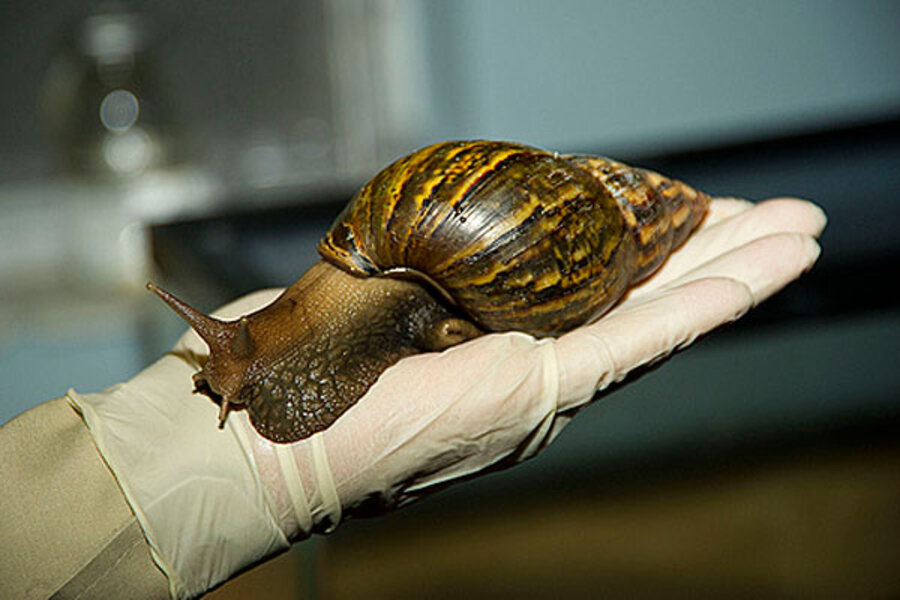Giant African snail killed to protect Australian crops
Loading...
Take look at the Giant African snail (Lissachatina fulica), and you can't help but be reminded of a scene from the 1996 movie Crocodile Dundee.
Our Australian hero Mick Dundee is approached by mugger in New York City. Dundee's girl warns him, "he's got a knife." Dundee replies, "That's not a knife," and he pulls out a foot-long Bowie knife."That's a knife."
You could imagine a similar scene playing out in a Brisbane, Australia, shipyard when a worker stumbled upon a Giant African snail.
This snail was almost as big as Mick Dundee's knife.
The Giant African snail can grow up to a foot in length and weigh up to 2 pounds. This particular specimen – about the size of a cricket ball – was quickly destroyed by Australia's Department of Agriculture, Fisheries, and Forestry.
The concern?
"Giant African Snails are one of the world’s largest and most damaging land snails," DAFF regional manager Paul Nixon said in a statement. The Brisbane Times reports that the "pest has an insatiable appetite and is capable of destroying 500 types of plants, including vegetable crops, fruit trees, and Australia’s native eucalypts"
‘‘Australia’s strict biosecurity requirements and responsive system has so far kept these pests out of Australia and we want to keep it that way," said Nixon.
Australian officials are no doubt aware of the battle that Floridians are now fighting with Giant African Snails, a rather pernicious invasive species.
This is how the US Department of Agriculture describes the exotic pest in a blog entitled: "Escargot? More like Escar-no!"
"Big and slimy, the giant African snail is well-equipped to become an invasive species: they have voracious appetites, reproduce quickly, live a long time, and have no natural predators in Florida. The first snails were discovered and reported by a Miami homeowner in September 2011. In just six months, APHIS and FDACS have collected more than 40,000 of these giant creepy crawlies.
Originally from East Africa, the snail has established itself throughout the Indo-Pacific Basin, including the Hawaiian Islands, and has been introduced into the Caribbean. Like other invasive species, giant African snails could enter the United States as hitchhikers on imported cargo. More often than not, however, the snails are smuggled illegally into the United States as pets or for food. When released into the environment, they can wreak major havoc on agriculture and the environment—much like what is happening in Florida right now."
Australians have their own history, too, of battling a non-native species, the cane toad. The cane toad was introduced into Queensland in 1935 to combat a beetle infestation in the state's sugar-cane plantations. But as The Christian Science Monitor reports, "The experiment was a disastrous failure – the cane toads (native to South America) ignored the beetles but began chomping their way through plenty of other wildlife, from frogs and tadpoles to small lizards. Worse, the poison glands on their backs made them deadly to the crocodiles, mammals, snakes, and birds that tried to eat them.
The toads adapted superbly to the heat and humidity of tropical Queensland, and within decades began pushing south into New South Wales and west into the vastness of the Northern Territory."
Nearly eight decades later, the amphibious assault on cane toads continues in Australia. And Australians aren't eager to wage that battle with the Giant African snail.






